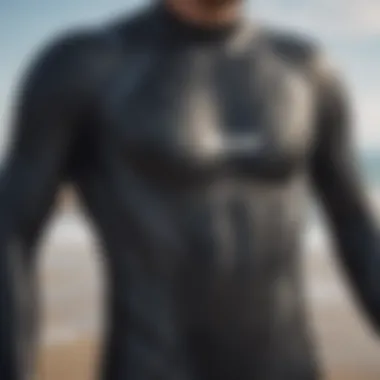Comprehensive Review of Vector Wetsuits for Kiteboarding


Intro
Understanding the right wetsuit can make all the difference for kiteboarders. This discussion explores vector wetsuits, shedding light on what sets them apart in a crowded market. These suits are not merely about keeping warm; they're about enhancing performance, making every ride enjoyable, and allowing water sports enthusiasts to focus on honing their skills.
In this guide, we’ll delve into the specifics including the materials used, design elements, and how these contribute to comfort and performance in varying conditions. With the right insights, kiteboarders can tailor their choices to match not just their physical requirements, but their personal style and preferences.
Equipment Insights
Latest Gear Reviews
Diving into the specifics of vector wetsuits, several models stand out. The Vector Pro Series, for instance, is crafted from high-grade neoprene. This provides superior flexibility and makes it easier to execute spins and jumps.
- Material Quality: The NeoSpandex enhances stretch while ensuring warmth. It’s lightweight, making it comfortable to wear over long periods.
- Sealed Seams: The glued and blind-stitched seams prevent water from trickling in, which is a must-have for cold water kiteboarding.
- Texture: The outer layer is designed for hydrodynamics, reducing drag as you ride through the waves.
Another noteworthy mention is the Vector Flexi-Wave. This model prioritizes breathability without sacrificing insulation. The addition of thermal linings keeps the core warm without the bulk.
- Breathable Zones: It uses micro-perforations in certain areas to let moisture escape whilst keeping wind chill at bay.
- Fit Options: Available in various fits catering to body shapes, ensuring comfort for every kiteboarder.
Essential Gear Maintenance
To get the most out of a vector wetsuit, proper care is essential. Here are some key tips:
- Rinse after Use: Always rinse your wetsuit with fresh water right after a session to remove salt and sand.
- Drying: Hang it out to dry in the shade, avoiding direct sunlight to prevent material degradation.
- Storage: It’s important to store the suit flat or hung up without folding to avoid creases that can cause damage over time.
Proper maintenance extends the life of your wetsuit and keeps it performing at its best!
Performance Analysis
Flexibility and Freedom of Movement
Flexibility is crucial for kiteboarding, and vector wetsuits excel in this area. Their design incorporates anatomical shaping, which contours to your body movements.
- Projection Cut: This allows for an unrestricted range of motion, which is critical when executing complex maneuvers.
- Limb Design: The limbs use an articulated fit, facilitating both peddling and aerial movements seamlessly.
Thermal Insulation
In cooler conditions, maintaining body temperature is key. Vector wetsuits employ multi-layer insulation strategies that trap heat while allowing excess moisture to escape. Some features include:
- Variable Thickness: Thicker panels in crucial areas maintain warmth, while thinner regions provide breathability.
- Chambered Design: Certain models include air pockets that further enhance thermal retention without adding bulk.
End
Investing in a vector wetsuit goes beyond simple functionality. It’s about elevating your kiteboarding experience through thoughtful design and innovative materials. Whether you're just starting or looking to refine your skills, understanding the nuances of these wetsuits will lead to better choices for your adventures on the water. With the right gear, every kiteboarding session can be an invigorating dance with nature.
Overview of Vector Wetsuits
Vector wetsuits play a pivotal role in the world of kiteboarding, an exhilarating sport that balances thrill with technical expertise. Understanding what these wetsuits offer can significantly enhance the riding experience. They aren't just garments; they are meticulously engineered suits designed to provide several benefits while tackling water conditions that can sometimes be demanding. By exploring the nuances of vector wetsuits, kiteboarders can better appreciate the thoughtful design and materials that contribute to their performance.
Definition and Purpose
Simply put, vector wetsuits are specialized suits made primarily for water sports, especially kiteboarding. The primary goal of these wetsuits is to keep the rider warm and protected from the elements while ensuring they have the flexibility to move freely. This is essential in kiteboarding, where agility and comfort dictate how well a rider can perform.
The materials used—often advanced neoprene—are selected for their insulating properties, allowing for extended sessions in colder waters without sacrificing mobility. In moments when every second counts, a well-fitted vector wetsuit can make the difference between a smooth maneuver and an unintended fall.
Historical Context
Understanding the historical background of vector wetsuits gives insight into their evolution and enhancement over the years. The original wetsuits, which emerged in the mid-20th century, were developed primarily for surfers. They were rudimentary, often made from heavy rubber that limited flexibility. Over time, as kiteboarding gained popularity, the need for more specialized suits surged.
Innovations in materials and design led to the emergence of vector wetsuits—lightweight yet sturdy versions that catered explicitly to the expectations of kiteboarders. In the early days of kiteboarding, enthusiasts often resorted to standard surf suits, but those lacked the functional elements necessary for the sport. As kiteboarding culture grew, so did the demand for equipment that could withstand the rigors of the water environment while supporting performance.
Today, vector wetsuits embody years of research and testing. They are designed with advanced manufacturing techniques and influenced by user feedback, producing a garment that aligns closely with the specific needs of kiteboarders. A vector wetsuit isn't merely a choice; it's an investment into the overall kiteboarding experience, making it critical for enthusiasts to consider both the history and advancements of these suits when selecting their gear.
Materials Used in Vector Wetsuits


The choice of materials in vector wetsuits is a lynchpin for their effectiveness in kiteboarding. It influences not only the durability and comfort of the wetsuit but also its overall performance in various water conditions. Understanding the materials at play can greatly aid kiteboarding enthusiasts—be it beginners or seasoned aces—in their decision-making processes.
Neoprene Types and Properties
When we talk about wetsuits, neoprene is the king. Most vector wetsuits are constructed from this synthetic rubber, which provides flexibility and insulation crucial for kiteboarders. However, not all neoprene is created equal. There are different types that vary in thickness, density, and overall performance.
- Standard Neoprene: This is the go-to option for many. It's relatively affordable and offers decent warmth. However, it may not suffice for extreme conditions where thermal protection is critical.
- Super Stretch Neoprene: This type provides maximum flexibility without sacrificing warmth. It's a great width for those tricks that require a full range of motion.
- Neoprene with Air Cells: Designed for superior buoyancy and insulation, this type is ideal for cold water kiteboarding. The air pockets trap body heat while minimizing bulk, allowing for greater maneuverability.
Each neoprene type has its merits, but it’s essential to consider the local climate and water temperature when making a choice. As a mantra in kiteboarding goes: "Stay warm to ride long."
Sustainability Considerations
In an era increasingly captivated by environmental concerns, the sustainability of wetsuit materials warrants attention. Many manufacturers are shifting towards eco-friendly neoprene alternatives, often derived from limestone instead of petroleum. This not only lessens the environmental footprint during production but also improves overall comfort.
Additionally, some brands are exploring renewable resources, such as natural rubber, which can reduce reliance on non-renewable materials considerably. Choosing wetsuits made from these materials can contribute to sustainability, allowing kiteboarders to enjoy their sport with a cleaner conscience.
"Investing in eco-friendly gear doesn’t just help the planet; it also often leads to better performance and comfort on the water."
Furthermore, proper maintenance can extend the lifespan of these wetsuits. Regularly rinse with freshwater, avoid exposing them to direct sunlight, and store them flat instead of hanging. Mindful care can ensure that your wetsuit maintains its properties for a long time, benefiting both the user and the environment.
Design Features
When it comes to kiteboarding, every detail counts. The design features of vector wetsuits play a crucial role in how they perform in action. We will delve into some key aspects, such as cut and fit as well as seam technology, to understand how they add value to the overall experience of kiteboarding.
Cut and Fit
The cut and fit of a wetsuit are more than merely how it looks; it’s about performance and comfort. A well-fitted wetsuit allows for unrestricted movement while providing support where needed.
Body Mapping Technology
Body mapping technology is at the forefront of creating wetsuits tailored to the unique contours of human anatomy. It considers factors like muscle structure and movement patterns, optimizing both comfort and performance.
One standout characteristic of body mapping is its ability to enhance water flow around the body. This means, when kiteboarding, the wetsuit can reduce drag, ultimately boosting speed and agility. However, not all body mapping designs are equal. Some may focus too much on flexibility at the expense of insulation, which could be a drawback in colder waters.
This technology is quite popular among serious kiteboarders, as it helps reduce fatigue during extended sessions. Having a wetsuit that moves with you instead of against you is a game-changer on the water.
Impact of Fit on Performance
The impact of fit on performance cannot be overstated. A wetsuit that is too loose can lead to water pooling inside, making the wearer cold and less agile. Conversely, a suit that is too tight can restrict movement, leaving the rider feeling uncomfortable.
The key characteristic here is that the right fit directly influences how well you can perform your tricks and maneuvers. A snug fit contributes to better responsiveness, which is crucial when you’re trying to nail down that tricky jump or swift turn. However, there’s always a fine line to walk between snug and restrictive.
Much like how you wouldn't wear a straitjacket to an acrobatic performance, a wetsuit has to balance comfort and functionality.
Seam Technology
Let’s move on to seam technology, which often gets overlooked but plays a significant role in the durability and water-resistance of wetsuits. This section sheds light on the variety of seams available and how they enhance the functionality of vector wetsuits.
Types of Seams
There are several types of seams commonly found in vector wetsuits, each serving a specific purpose. Flatlock seams are one of the most basic, ideal for warm water scenarios as they tend to be bulkier, providing more comfort than insulation. On the other end of the spectrum, blind-stitched seams offer superior insulation by minimizing water entry, suitable for colder conditions.
This contrast mirrors the popular saying, "You get what you pay for." High-quality seam types generally lead to better durability, ensuring the wetsuit withstands wear and tear over time.
Seam Sealing Methods
When it comes to seam sealing methods, sealed seams take center stage. These methods are crucial for anyone serious about maximizing their time on the water. Glued and blind-stitched seams stand out among the crowd; they seal the gaps that could let in water, keeping users warmer for longer.
One unique feature of seam sealing methods is the use of neoprene tape, which reinforces seams and adds an extra layer of protection. However, it’s important to note that while these methods improve insulation and water resistance, they may also increase the cost of the wetsuit.
In summary, the design features of vector wetsuits, ranging from cut and fit to seam technology, greatly affect performance and experience on the water. Picking the right combination of these elements can be the difference between a pleasant day of kiteboarding and a cold, uncomfortable ride.
Performance Attributes


When contemplating the significance of performance attributes in vector wetsuits designed for kiteboarding, one must consider how these traits directly influence a rider’s comfort and capability on the water. Performance attributes—such as thermal insulation and flexibility—are essential, not just for enjoyment but also for safety and efficiency. They can make or break a kiteboarding session, particularly when varying environmental conditions are in play.
Thermal Insulation
Importance in Cold Conditions
Thermal insulation in wetsuits is pivotal, especially for kiteboarders who often face biting winds and chilly waters, which can sap body heat faster than you can say "stay warm". This characteristic is of utmost importance as it ensures that riders maintain their body temperature and thus their performance. A wetsuit with excellent thermal insulation will help prevent muscle stiffness and fatigue, allowing for extended periods on the water without succumbing to the cold.
Moreover, the unique feature of vector wetsuits is their use of advanced insulating materials, which provide robust protection while remaining lightweight. By minimizing heat loss yet maximizing buoyancy, these suits are favored among enthusiasts who dare to ride when temperatures drop. This is precisely why many kiteboarders view garments boasting strong thermal insulation as a beneficial choice for their adventure.
Comparative Analysis with Other Wetsuits
In the landscape of wetsuit options, a comparative analysis reveals that vector wetsuits stand toe-to-toe, if not ahead, of their competitors in terms of thermal insulation performance. When stacked against traditional neoprene suits, vector wetsuits often employ innovative thermal technologies that deliver superior warmth without adding bulky thickness. This ensures kiteboarders can retain a high degree of flexibility while also enjoying exceptionally warm functionality.
However, not all wetsuits are created equal. Some may offer thick padding at the cost of mobility, which can hinder performance during intricate movements. Leaving behind those obstacles, vector’s adept design blends warmth and athleticism effectively, making it a top pick for users.
Flexibility and Mobility
Impact on Water Maneuverability
Flexibility is another cornerstone of performance for kiteboarding wetsuits, as it dramatically impacts a rider’s ability to maneuver quickly and efficiently on the water. If you can't move freely, you're not going to perform your best. The benefit of superior flexibility is evident every time a kiteboarder executes a slick move, whether it's a jump or a turn. In fact, the unique engineering behind vector wetsuits promotes uninhibited movement, allowing for more aggressive riding styles without the fatigue that can accompany restricted movement.
In contrast, wetsuits with poor flexibility can sap enjoyment and safety alike. Kiteboarders might find themselves straining against their gear rather than expressing their full potential on the waves. Hence, incorporating designs that prioritize freedom of movement is consequently a wise decision for riders at any expertise level.
User Experience Reports
The value of user experience reports cannot be overstated; they often reflect real-world applications of the technology at hand. Many kiteboarders laud the flexibility of their vector wetsuits, sharing anecdotes of how this feature has improved their ride. Surfers recount being able to adjust their posture fluidly, capturing the wind and waves with grace. They emphasize that movement feels natural, as though the wetsuit is a second skin, enhancing their overall riding experience.
However, it's important to scrutinize these reports for balance. While many praise the flexibility of vector wetsuits, some reviews have noted that specific high-end models may come at a premium. Riders looking for performance should weigh the benefits of top-tier flexibility against their budget, ensuring they don’t end up with a suit that doesn't meet their needs.
"A good wetsuit should feel like a warm hug on a frigid day, not a straightjacket!" - Anonymous kiteboarder
In summary, the performance attributes of vector wetsuits—especially thermal insulation and flexibility—are critical considerations for kiteboarding enthusiasts. They are designed to enhance the overall experience by ensuring riders can stay warm while enjoying maximum freedom of movement. By diving into these aspects, individuals can better articulate their preferences and needs in selecting the right wetsuit for their kiteboarding adventures.
Choosing the Right Vector Wetsuit
Choosing the right wetsuit isn’t just a matter of fashion; it plays a crucial role in a kiteboarder’s overall experience. Picking the right wetsuit directly impacts comfort, warmth, and agility on the water. It sets the stage for those exhilarating moments when one glides over the water, navigating the waves like a pro. Whether you're a beginner or a seasoned rider, understanding how to select the most suitable wetsuit tailored to your needs can enhance your performance significantly.
Factors to Consider
Here's what you should keep at the forefront when making your choice:
Body Type and Dimensions
When examining body type and dimensions, it’s essential to realize that each wetsuit is designed with specific shapes in mind. This aspect contributes heavily to overall fit and comfort while riding. Wetsuits that conform well to the body's contours minimize water intrusion, reducing drag. For example, if you are more athletic with broad shoulders, finding a wetsuit that accommodates that frame can make all the difference. Such a wetsuit can provide not just mobility but also an ease of movement that amplifies performance.
However, if the fit is too tight or too loose, that can lead to discomfort or hindered performance. It’s about striking that balance. A key consideration is the stretch properties of the material as well. Neoprene melting around the contours of your body can aid in providing that snug fit without hampering your freedom of movement.
Water Conditions and Climate
The specific conditions of water and climate at your favorite kiteboarding spot greatly influence wetsuit choice. For instance, warmer waters might require a thinner wetsuit, while colder locations absolutely call for something with more thickness to ensure adequate insulation. An important characteristic of wetsuits is their thermal regulation capability.
A unique feature in many modern wetsuits, including vector designs, is their thermal lining, which helps trap warmth while allowing moisture to escape. This is particularly beneficial in variable weather conditions, where the temperature can shift throughout the day. Knowing your typical riding conditions will save you from making a common error: wearing a shorty suit when you really need a full suit. That's a surefire way to make a kiteboarding session less enjoyable and rather chilly instead.
Common Mistakes to Avoid
While selecting the perfect wetsuit, kiteboarders may find themselves falling into traps that can lead to less-than-ideal experiences.
- Skipping the Try-On: Always try on the wetsuit before committing. A right fit can feel much different than the numbers suggest.
- Overthinking Thickness: Going too thick or too thin is a common pitfall. Make sure to consider the average conditions of your primary riding location.
- Neglecting Flexibility: Just because a wetsuit looks great doesn’t mean it’s right for you. Check flexibility, as it dramatically affects performance.
Ultimately, choosing the right vector wetsuit requires a bit of thought but is well worth the effort to ensure you fully enjoy your kiteboarding adventures. Finding that ideal fit can mean the difference between a decent day out on the water and an unforgettable experience.
"In the world of kiteboarding, your gear tells a significant story about your preparation and performance. Choose wisely."


Exploring these factors ensures you end up with a wetsuit that fits like a glove and embodies durability and comfort while you cut through wind and wave.
Maintenance and Care
Taking proper care of your Vector wetsuit is essential. Neglecting maintenance can lead to a shorter lifespan for the suit and can affect your performance on the water. Maintaining your wetsuit involves cleaning it properly and storing it correctly. By understanding how to care for your wetsuit, you not only enhance its longevity but also ensure it continues to perform at its best. In this section, we will delve into critical aspects regarding the cleaning protocols and storage recommendations that kiteboarding enthusiasts should follow.
Cleaning Protocols
Cleaning your wetsuit might seem like a mundane task, but doing it right can make a significant difference. Ideally, you should rinse the suit after each use. Freshwater helps to remove salt, chlorine, and sand that can degrade the materials over time. Here's a simple process:
- Rinse Immediately: As soon as you exit the water, rinse your wetsuit in freshwater. Hang it over a rail or lay it flat to avoid creasing.
- Use a Gentle Detergent: If it's been a while since the last wash or if your suit has been used in particularly dirty water, use a specialized wetsuit cleaner instead of regular laundry detergents. Harsh chemicals can harm the neoprene.
- Cold Water Only: Always wash in cold water. Hot water can break down the neoprene and reduce elasticity.
- Hang Dry: After rinsing, hang the wetsuit upside down on a wide hanger to air dry. Avoid direct sunlight, as prolonged exposure can lead to fading and material breakdown.
Taking these small but effective steps not only keeps your gear looking sharp but also prevents buildup that can lead to odors or mold.
Storage Recommendations
Proper storage is just as crucial as cleaning. How you store your wetsuit can seriously affect its condition when you're ready to use it again. Here are a few key points to ensure you store your wetsuit correctly:
- Avoid Folding: Never fold your wetsuit; this creates creases that can become permanent. Instead, hang it up on a wide hanger.
- Cool, Dark Place: Store the wetsuit in a cool, dark place, away from windows and direct heat sources like radiators. High temperatures can degrade the material and weaken its structure.
- Keep Away from Heavy Items: Ensure there are no heavy objects resting on top of your wetsuit while stored. Weight can compress the material leading to permanent dents or even tears over time.
- Periodic Checks: During storage, it's wise to periodically check your wetsuit for any signs of mold, wear or even pests. Catching issues early can save you a lot of hassel later.
Following these guidelines can greatly enhance the lifespan of your Vector wetsuit, keeping it ready for your kiteboarding adventures. As you invest in quality gear, putting effort into its maintenance reflects the same commitment to performance and ambition on the water.
Reviews and Comparisons
When it comes to purchasing Vector wetsuits for kiteboarding, reviews and comparisons play a critical role. These insights serve as a guiding light for enthusiasts navigating the often overwhelming sea of options available. Reviews offer firsthand accounts of a particular wetsuit's performance, from thermal retention to mobility in water. Understanding what's been said can shift the balance between making a well-informed purchase or regretting a choice that doesn’t align with one's needs.
Expert Opinions
Expert opinions often paint a vivid picture of the subtle nuances of Vector wetsuits. Professionals who have long been in the kiteboarding sphere often carry a wealth of knowledge regarding what makes or breaks a wetsuit. Many of them dive deep into performance metrics, highlighting aspects like durability, comfort, and effectiveness.
For instance, a kiteboarding instructor may emphasize the importance of a snug fit in ensuring the wetsuit doesn’t fill with water during high-speed maneuvers. They might mention the impact of specific neoprene types on water temp management, stating how certain models offer enhanced insulation without sacrificing flexibility.
In addition to physical attributes, experts often focus on long-term use. They share advice regarding the materials used in construction and how they hold up under repeated exposure to saltwater and sunlight. Catching these details is essential as they not only inform user expectations but also enhance the overall kiteboarding experience.
“A wetsuit that allows you to move freely can be the difference between a great day on the water and an aggravating one. Flexibility should never be compromised.”
User Testimonials
User testimonials brimming with personal experiences are another layer of depth that should not be overlooked. When regular kiteboarders share their stories, they often underscore how a specific Vector wetsuit changed their experience on the water – or, conversely, how a poor choice led to frustrating outings.
Many testimonials address real-world conditions, weaving narratives that spotlight the wetsuit's performance across various elements. Some users rave about a particular model's effectiveness in harsh temperatures, while others critique its weight and how it might affect their speed on the water. The power of these shared experiences lies in their diversity:
- Comfort in Cold Weather: A user aquainted with frigid conditions might express how their Vector wetsuit kept them warm and agile.
- Mobility in Action: Another kiteboarder describes how unrestricted movement allowed for exceptional trick execution, changing how they approached their sport.
- Longevity and Care: Some individuals go beyond performance, discussing how well the wetsuit has held up after several seasons and offering care tips that can prolong its lifespan.
These real-life evaluations equip potential buyers with a well-rounded perspective, revealing not just the positives but also potential drawbacks that may not be apparent during a storefront try-on. Embracing user experiences allows newcomers to avoid pitfalls and select a wetsuit that aligns well with their expectations and physicality.
Future Trends in Wetsuit Technology
The world of wetsuits is ever-evolving, especially with the surge in kiteboarding's popularity. As enthusiasts look for gear that enhances their experience on the water, understanding the future trends in wetsuit technology becomes crucial. Not only does it shape the performance of the equipment itself, but it also ensures that users stay comfortable and safe in varying conditions. New technologies promise not just advances in warmth and flexibility, but also improvements in sustainability and functionality.
Innovations on the Horizon
Coming innovations in wetsuit technology hint at exciting possibilities. For starters, 4D knitting techniques could redefine how wetsuits are crafted, allowing for more precision in fit and function. This method uses advanced machines to create materials that provide both warmth and unparalleled stretch. Kiteboarders might appreciate how this enhances mobility, making it easier to execute complex maneuvers.
A notable mention is the development of biodegradable neoprene. As environmental concerns rise, manufacturers are seeking ways to reduce their carbon footprint. This shift isn't merely a marketing gimmick; the aim is to produce wetsuits that decompose without leaving a harmful legacy behind.
Some upcoming wetsuits will integrate advanced hydrophobic coatings that repel water more effectively. This feature not only aids in thermal retention by minimizing trapped water but also enhances drying times. Imagine emerging from the water and your suit dries almost instantly—now that's a game changer!
Additionally, sensory technology, like integrated temperature sensors, could hit the market soon. These systems could track body temperature and adjust insulation through smart materials, ensuring kiteboarders remain at optimal performance levels without overheating or getting too cold.
Potential Impacts on Kiteboarding
The innovations mentioned earlier hold great potential for the kiteboarding community. More tailored fits from advanced knitting techniques can enhance the overall experience. Comfort leads to confidence, and with improved flexibility, riders may be able to push their limits further, experimenting with new moves and techniques.
The introduction of sustainable materials aligns with a growing consciousness in the kiteboarding community about the environment. Kiteboarders often spend time in pristine locations, and ensuring gear has minimal environmental impact speaks volumes to eco-conscious enthusiasts.
Real-time monitoring via temperature sensors could serve as a safety feature, an imperative aspect in unpredictable weather conditions. No one wants to find out mid-session that their suit isn't keeping them warm enough.
All these trends suggest a thrilling future for wetsuit technology. As these features become mainstream, kiteboarders can expect gear that not only meets their performance desires but also aligns with their values and commitment to sustainability.
"The key to innovation is understanding the needs of the consumer while staying ahead of environmental challenges."







